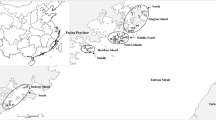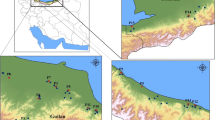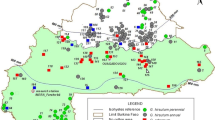Abstract
Gossypium mustelinum is a wild cotton relative found only in the semiarid region of Bahia state in Brazil, and changes caused by humans in the natural habitat of this species have endangered the existence of several natural populations. Information about the occurrence and genetic composition of these populations is necessary to design effective conservation measures. The aim of this study was to characterize the in situ maintenance mode and assess the genetic diversity of G. mustelinum populations in the basin of the De Contas River. A sample of 205 G. mustelinum specimens was collected from the margins of the Jacaré, Riacho Quixaba, Riacho Serra Azul, and Riacho Riachão rivers and genotyped using 13 SSR primer pairs. In general, all G. mustelinum populations exhibit inadequate in situ maintenance, predominantly due to the deforestation of riparian vegetation and herbivory. The observed total genetic diversity of G. mustelinum was significant (H E = 0.489), highly structured (F ST = 0.534), and organized in homozygous genotypes (F IS = 0.873). The high observed inbreeding level is consistent with the predominance of self-fertilization and geitonogamy (t m = 0.234). In addition, the pattern of genetic structure tended to form groups that coincided with the collection sites, i.e., first clustering within subpopulations, then within populations, and finally within the closest populations. Thus, the observed genetic diversity is likely to be rapidly lost, and conservation measures should therefore be undertaken.




Similar content being viewed by others
References
Albrana (2013) Brazilian native and naturalized cotton. http://www.cnpa.embrapa.br/albrana. Accessed 10 Feb 2013
Almeida VC, Hoffmann LV, Yokomizo GK, Costa JN, Giband M, Barroso PAV (2009) In situ and genetic characterization of Gossypium barbadense L. from the States of Pará and Amapá, Brazil. Pesq Agropec Bras 44:719–725. doi:10.1590/S0100-204X2009000700011
Alves MF, Barroso PAV, Ciampi AY, Hoffmann LV, Azevedo VCR, Cavalcante U (2013) Diversity and genetic structure among subpopulations of Gossypium mustelinum (Malvaceae). Genet Mol Res 12:597–609. doi:10.4238/2013.February.27.9
Barroso PAV, Hoffmann LV, Alves MF, Freitas RB (2007) Aplicabilidade de Marcadores SSR em Estudos Genéticos em Gossypium mustelinum Miers. Embrapa CNPA, Campina Grande. Available from Centro Nacional de Pesquisa do Algoda˜o, Campina Grande, PB, Brazil. Publ. comunicado técnico no. 345
Barroso PAV, Hoffmann LV, Batista CE, Freitas RB, Alvez MF, Silva UC, de Andrade FP (2010) In situ conservation and genetic diversity of three populations of Gossypium mustelinum Miers (ex Watt). Genet Resour Crop Evol 57:343–349. doi:10.1007/s10722-009-9472-9
Bertini MCH, Schuster I, Sediyama T, Barros EG, Moreira MA (2006) Characterization and diversity analysis of cotton cultivars using microsatellites. Genet Mol Biol 29:321–329
Bowcock AM, Ruiz-Linares A, Tomfohrde J, Minch E, Kidd JR, Cavalli-Sforza LL (1994) High resolution of human evolution with polymorphic microsatellites. Nature 368:455–457. doi:10.1038/368455a0
Castelletti CHM, Santos AMM, Tbarelli M, Siva JMC (2003) Quanto ainda resta da Caatinga? Uma estimativa preliminar. In: Leal IR, Tabarelli M, Silva JMC (eds) Ecologia e conservação da caatinga. Universitária da UFPE, Recife, pp 719–734
CMD (2013) Cotton data marker base. http://www.cottonmarker.org. Accessed 1 Jan 2013
DArT (Diversity Arrays Technology) (2009) Protocolo de extração de DNA de plantas. http://www.DiversityArrays.com/pub/DArT_DNA_isolation.pdf. Accessed 10 Jan 2009
de Menezes IPP, Barroso PAV, Hoffmann LV, Lucena VS, Giband M (2010) Genetic diversity of mocó cotton (Gossypium hirsutum race marie-galante) from the northeast of Brazil: implications for conservation. Botany 88:1–9. doi:10.1139/B10-045
Ellstrand NC, Elam DR (1994) Population genetic consequences of small population size: implications for plant conservation. Annu Rev Ecol Syst 24:217–242. doi:10.1146/annurev.es.24.110193.001245
Evanno G, Regnaut S, Goudet J (2005) Detecting the number of clusters of individuals using the software structure: a simulation study. Mol Ecol 14:2611–2620. doi:10.1111/j.1365-294X.2005.02553
Freire EC (2002) Viabilidade de cruzamentos entre algodoeiros transgênicos e comerciais e silvestres do Brasil. Rev bras ol fibros 1:465–470. http://www.cnpa.embrapa.br/ojs/index.php/RBOF/article/view/132
Gao H, Williamson S, Bustamante CD (2007) An MCMC approach for joint inference population structure and inbreeding rates from multi-locus genotype data. Genetics 176:1635–1651. doi:10.1534/genetics.107.072371
Gardunia BW (2006) Introgression from Gossypium mustelinum and Gossypium tomentosum into upland cotton, Gossypium hirsutum. Thesis, Texas A&M University
Goudet J (2001) FSTAT: program to estimate and test gene diversities and fixation indices (software). Version 2.9.3. http://www2.unil.ch/popgen/softwares/fstat.htm. Accessed 20 Dec 2009
Hague SS, Smith CW, Stelly DM, Souder C, Thaxton P (2007) Combining ability and utility of interspecific Gossypium matings. International Cotton Advisory Committee. http://wcrc.confex.com/wcrc/2007/techprogram/MEETING.HTM. Accessed 1 June 2009
Lewis P, Zaykin D (2001) Genetic data analysis: computer program for the analyses of allelic data. Version 1.1 (win32). http://hydrodictyon.eeb.uconn.edu/people/plewis/software.php. Accessed 20 Dec 2009
McGregor SE (1976) Insect pollination of cultivated crop plants. U.S.D.A. Agriculture Handbook No. 496
Nei M (1978) Estimation of average heterozygosity and genetic distance from a small number of individuals. Genetics 89:583–590
Neves OS, Cavaleri PA, Gridi-Papp IL, Fuzzato MG (1965) Algodoeiro selvagem nordeste do Brasil. Bragantia 24:19–25
Neves OS, Cavaleri PA, Ferraz CAM, Fuzzato MG, Silva NM, Schmidt W, Corrêa DM (1968) Distribuição geográfica atual dos algodoeiros perenes no Brasil. Bragantia 35:437–475
Pereira GS, Sousa RL, Araújo RL, Silva EF, Hoffmann LV, Barroso PAV (2012) Selective fertilization interspecific crosses of allotetraploid species Gossypium. Botany 90:159–166. doi:10.1139/b11-094
Pickersgill B, Barrett SCH, Lima AD (1975) Wild cotton in northeast Brazil. Biotropica 7:42–54
Prado DE (2003) As caatingas da America do Sul. In: Leal IR, Tabarelli M, Silva JMC (eds) Ecologia e conservação da caatinga. Universitária da UFPE, Recife, pp 3–74
Reed HD, Frankham R (2003) Correlation between fitness and genetic diversity. Conserv Biol 1:230–237. doi:10.1046/j.1523-1739.2003.01236
Ritland K (2002) Extensions of models for the estimation of mating systems using an independent loci. Heredity 88:221–228. doi:10.1038/sj.hdy.6800029
Schuster I, Queiroz VT, Teixeira AI, Barros EG, Moreira MA (2004) Determinação da pureza varietal de sementes de soja com o auxílio de marcadores moleculares microssatélites. Pesquisa Agropecuaria Brasileira 39:247–253
Rosenberg NA (2004) Distruct: a program for the graphical display of population structure. Mol Ecol Notes 4:137–138. doi:10.1046/j.1471-8286.2003.00566
Tamura K, Peterson D, Peterson N, Stecher G, Nei M, Kumar S (2011) Mega5: molecular evolutionary genetics analysis using maximum likelihood, evolutionary distance, and maximum parsimony methods. Mol Biol Evol 28:2731–2739. doi:10.1093/molbev/msr121
Vaz ARC, Borba TCO, Brondani C, Rangel PHN, Camargo GSO, Telles MPC, Diniz Filho JAF, Brondani RPV (2009) Genetic analysis of a local population of Oryza glumaepatula using SSR markers: implications for management and conservation programs. Genetica 137:221–231. doi:10.1007/s10709-009-9393-8
Weir BS, Cockerham CC (1984) Estimating F-statistics for the analysis of population structure. Evolution 38:1358–1370. doi:10.2307/2408641
Wendel JF, Brubaker CL, Perciva IAE (1992) Genetic diversity in Gossypium hirsutum and the origin of upland cotton. Am J Bot 79:1291–1310
Wendel JF, Rowley R, Stewart JMD (1994) Genetic diversity in and phylogenetic relationships of the Brazilian endemic cotton, Gossypium mustelinum (Malvaceae). Plant Syst Evol 192:49–59. doi:10.1007/bf00985907
Westengen OT, Huamán Z, Heun M (2005) Genetic diversity and geographic pattern in early South American cotton domestication. Theor Appl Genet 110:392–402. doi:10.1007/s00122-004-1850-2
Acknowledgments
To Roberto Augusto Leal Guimarães for his assistance during the expedition. To Empresa Brasileira de Pesquisa Agropecuária (Embrapa) and Financiadora de Estudos e Projetos (FINEP) for financing support. To Fundação de Apoio à Pesquisa do Estado da Bahia (FAPESB) for the doctoral scholarship to I. P. P. Menezes. Study conducted under authorization 13973 of the Instituto Brasileiro do Meio Ambiente e dos Recursos Naturais Renováveis (IBAMA).
Author information
Authors and Affiliations
Corresponding author
Rights and permissions
About this article
Cite this article
de Menezes, I.P.P., Gaiotto, F.A., Hoffmann, L.V. et al. Genetic diversity and structure of natural populations of Gossypium mustelinum, a wild relative of cotton, in the basin of the De Contas River in Bahia, Brazil. Genetica 142, 99–108 (2014). https://doi.org/10.1007/s10709-014-9757-6
Received:
Accepted:
Published:
Issue Date:
DOI: https://doi.org/10.1007/s10709-014-9757-6




